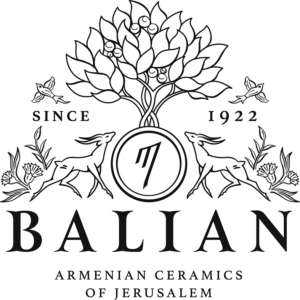Fired by history
Saturday, February 13, 1999
As the political fortunes of Palestine turn again, Michael Jansen talks to Armenian potters who have laboured there for centuries, and whose fate follows the whim of their adopted country’s history.
In 1919 two Armenian ceramicists emigrated from the Turkish town of Kutahya to Jerusalem. They had been commissioned by the new British mandatory administration to restore to their former glory the ceramic tiles decorating the rotunda of the magnificent 7th-century Dome of the Rock. Built on the site of the mystical “Night Journey” of the Prophet Muhammad, the Dome and the adjacent al-Aqsa mosque constitute the third holiest shrine in the Muslim world, after Mecca and Medina.
The two men set up their kiln within the mosque compound on the very place where the existing damaged and faded tiles had been fired during the splendid renovations commanded by the Ottoman Caliph Suleiman the Magnificent in the 16th century.
The move to Palestine almost certainly saved their lives, for soon after they left home the Ottoman massacres of Armenians spread to Kutahya, which had taken over from Iznik as the Turkey’s major centre for pottery in the 17th century.
While they managed to repair and replace some of Suleiman’s tiles, the renovation work did not prosper. The raw materials the ceramists needed were not available in Palestine and communications with Turkey had been severed by the war and internal unrest so they could not bring supplies from Kutahya. There were differences between Sir Ronald Storrs, the British governor responsible, and the Muslim charitable trust, the “wakf”, which administers the site. Eventually, funds ran out.
Instead, the Armenians were employed by the municipality in making decorated pottery tiles inscribed with the street names of the old city – tiles which are still a characteristic of Jerusalem. In 1922 the men from Kutahya established a new workshop in what were open fields near the Anglican cathedral on Nablus Road, launching a partnership which lasted nearly 40 years between Neshan Balian, the master potter, and Mgerdich Karakashian, a gifted painter, and their descendants.
Although the partnership was amicably dissolved in 1965, both families remain true to their craft. The Balians continue to work in the original Palestine Pottery premises, while the Karakashians set up Jerusalem Pottery on the Via Dolorosa, the Way of the Cross, within the ancient walled city. Both firms have diversified from tiles into hand-painted plates, mugs and bowls.
In spite of the limited success of the original, 1922 effort, the Armenian potters have taken part in the two later renovations, 19601961 and 1995-1997 (when the Northern Ireland firm, Mivan, gilded the Dome), and are called in for running repairs from time to time. “Unfortunately the wakf prefers Turkish or Italian experts” to local artisans who intimately understand the sacred site, says Neshan Balian, the grandson and namesake of the founder.
The fortunes of the Armenian potteries have followed the political fortunes of Palestine. During Israel’s war of establishment in 1948, business collapsed. Under Jordanian rule, 1949-1967, the potters had a “good life, making good money … and having fun”, Balian said. There was minimal interference from the capital, Amman.
They were rewarded for their hard work in 1965 with a gold medal at an exhibition in Damascus. When Israel occupied East Jerusalem and the West Bank in 1967, it imposed a bureaucracy and multiplicity of taxes which stifled business and swallowed up profits. And still do. Then the Palestinian Rising, the Intifada, 1987-93, “brought us to our knees”, Balian asserts. During this period the wares in Palestine Pottery’s display window grew thick with dust and the street door remained closed for many months.
Today the firm is flourishing. It employs 13 potters and painters, Arab and Armenian, Muslim and Christian, all hired through family connections. Several daughters of the Muslim foreman, Abed Rashed, a veteran of 50 years, have worked as painters until they marry and have children. Neshan Balian, who has degrees in ceramic and mechanical engineering from Ohio University, soon learned that in his business “experience counts for 80 per cent”. His mother, Marie Balian, who is of French Armenian origin and studied at the Beaux Arts in Lyon, is the “artistic base” of the firm, he said.
Palestine Pottery’s work reflects four main influences: Turkish, Persian, Palestinian and, of course, Armenian. Turkish and Palestinian designs have geometric patterns; many of the Persian pieces are decorated with floral motifs; Armenian designs feature animals. The Balians make large murals using a dozen and more tiles. One of the most elegant, depicting a lion savaging a gazelle beneath a tree, is based on a mosaic floor from the 8th-century Hisham Palace in Jericho.
The matriarch, Marie Balian, who also designs murals to order, has exhibited in the Smithsonian Museum in Washington DC and the ALMA Museum of Boston. Palestine Pottery has also staged exhibitions in Tel Aviv and Amman, where, last July, the opening was opened by Queen Noor.





